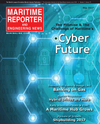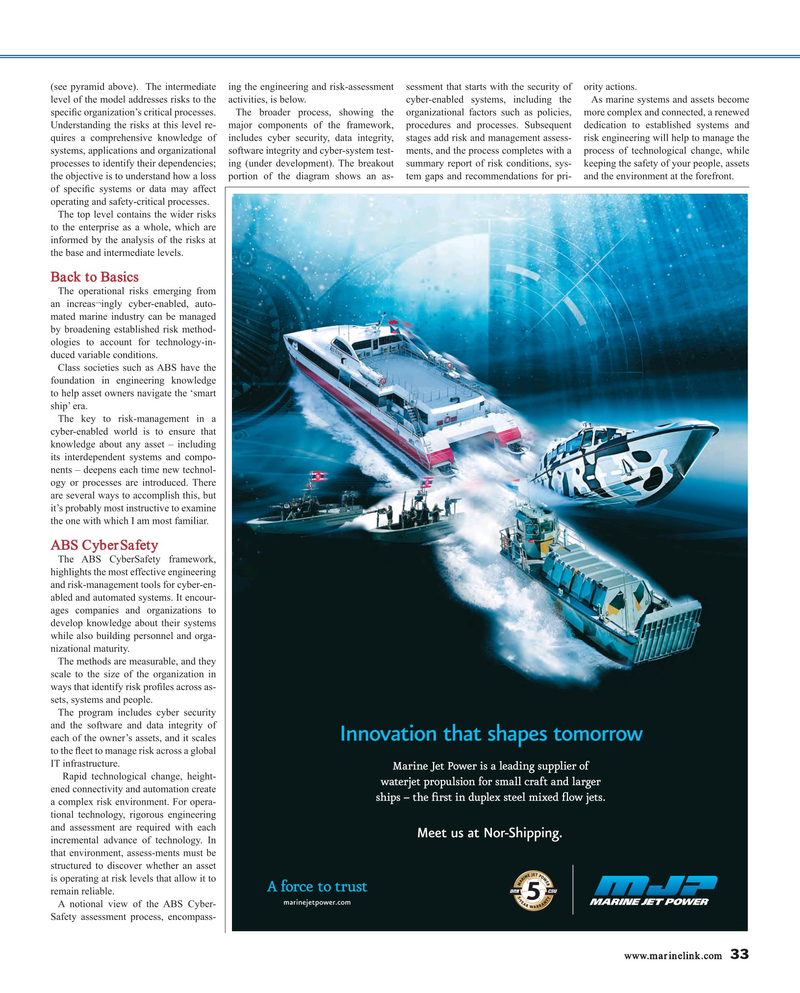
Page 33: of Maritime Reporter Magazine (May 2017)
The Marine Propulsion Edition
Read this page in Pdf, Flash or Html5 edition of May 2017 Maritime Reporter Magazine
(see pyramid above). The intermediate ing the engineering and risk-assessment sessment that starts with the security of ority actions. level of the model addresses risks to the activities, is below. cyber-enabled systems, including the As marine systems and assets become speci? c organization’s critical processes. The broader process, showing the organizational factors such as policies, more complex and connected, a renewed
Understanding the risks at this level re- major components of the framework, procedures and processes. Subsequent dedication to established systems and quires a comprehensive knowledge of includes cyber security, data integrity, stages add risk and management assess- risk engineering will help to manage the systems, applications and organizational software integrity and cyber-system test- ments, and the process completes with a process of technological change, while processes to identify their dependencies; ing (under development). The breakout summary report of risk conditions, sys- keeping the safety of your people, assets the objective is to understand how a loss portion of the diagram shows an as- tem gaps and recommendations for pri- and the environment at the forefront. of speci? c systems or data may affect operating and safety-critical processes.
The top level contains the wider risks to the enterprise as a whole, which are informed by the analysis of the risks at the base and intermediate levels.
Back to Basics
The operational risks emerging from an increas¬ingly cyber-enabled, auto- mated marine industry can be managed by broadening established risk method- ologies to account for technology-in- duced variable conditions.
Class societies such as ABS have the foundation in engineering knowledge to help asset owners navigate the ‘smart ship’ era.
The key to risk-management in a cyber-enabled world is to ensure that knowledge about any asset – including its interdependent systems and compo- nents – deepens each time new technol- ogy or processes are introduced. There are several ways to accomplish this, but it’s probably most instructive to examine the one with which I am most familiar.
ABS CyberSafety
The ABS CyberSafety framework, highlights the most effective engineering and risk-management tools for cyber-en- abled and automated systems. It encour- ages companies and organizations to develop knowledge about their systems while also building personnel and orga- nizational maturity.
The methods are measurable, and they scale to the size of the organization in ways that identify risk pro? les across as- sets, systems and people.
The program includes cyber security and the software and data integrity of
Innovation that shapes tomorrow each of the owner’s assets, and it scales to the ? eet to manage risk across a global
IT infrastructure.
Marine Jet Power is a leading supplier of Rapid technological change, height- waterjet propulsion for small craft and larger ened connectivity and automation create ships – the ?rst in duplex steel mixed ?ow jets.
a complex risk environment. For opera- tional technology, rigorous engineering and assessment are required with each
Meet us at Nor-Shipping.
incremental advance of technology. In that environment, assess-ments must be structured to discover whether an asset is operating at risk levels that allow it to remain reliable. marinejetpower.com
A notional view of the ABS Cyber-
Safety assessment process, encompass- www.marinelink.com 33
MR #5 (26-33).indd 33 MR #5 (26-33).indd 33 5/3/2017 8:23:21 PM5/3/2017 8:23:21 PM

 32
32

 34
34
